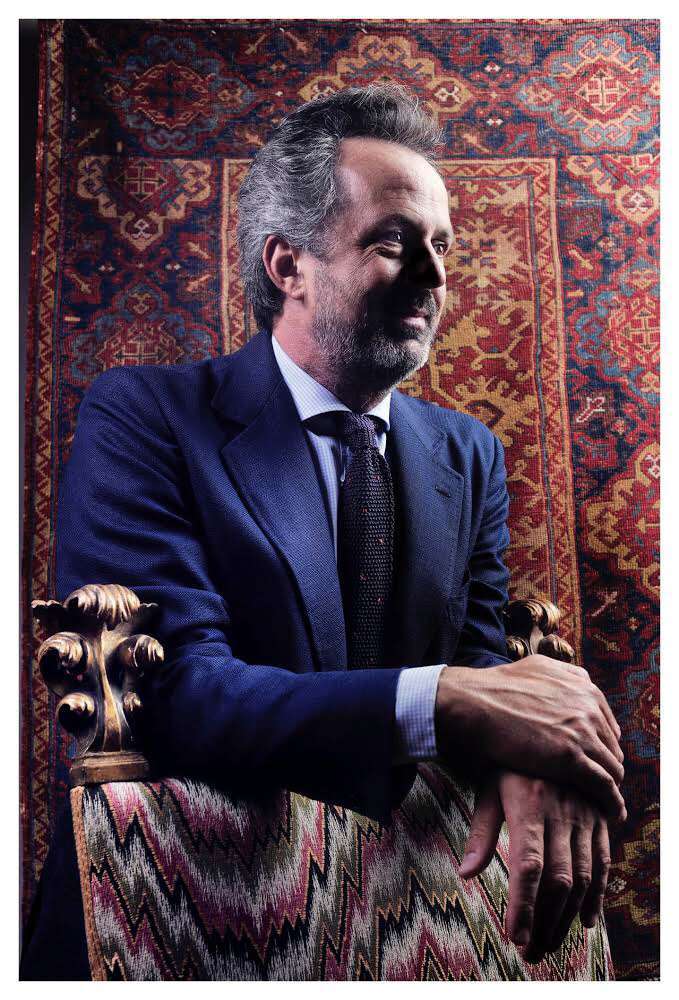Mirco Cattai, reserved antiquarian with an elegant style but above all a man with a great passion, that for Mohtashem - synonymous with the famous Persian annotator Mohtashem of the second half of the XNUMXth century – and it is with this name that the first gallery in Milan opens in 1993, in the very central via Manzoni and right next to the Teatro Manzoni.
When was your passion for antique carpets born?
It dates back to a long time ago, maybe it's a passion that wasn't born by chance, or maybe it was just the case that I fell in love with ancient carpets and tapestries. Over time I further specialized and participated in the most important antiques exhibitions from the Milanese antique dealers, the Milan international up to the Florence antiques biennial. I have always followed the art market and for many years also international exhibitions such as the Paris Biennale and Tefaf where I learned a lot. The gallery that bears my name today, in via Manzoni 12, specializes in antique carpets from the Persian, Caucasian, Chinese and above all Anatolian areas, including examples from the 700th century such as Ushak Tintoretto, Ushal Lotto and Medallion. Every year in my Gallery I prepare a Theme Exhibition in December and a Spring Exhibition in June on Asian Art, this year's Exhibition is called "XX Centuries of Sculptures". The Gallery wants to be a meeting place for collectors and enthusiasts, I often purchase objects or paintings, such as for example now you can find a very rare pair of 700th century "lobster" color lacquered Venetian armchairs, which I purchased from the Minnesota Historical Society from the Mary Griss Burke Collection, or like some beautiful view of Venice from the 800th century; this comes from my great passion for art. I've always preferred the carpet, I'm fascinated by the history, the culture behind it, especially the village production, such as Anatolians and Caucasians, where a nomad expresses himself in an extraordinary way by interpreting drawings and symbols of his own area, without even knowing how to read and writing, he creates true masterpieces of art, then towards the end of the XNUMXth century it all ends when European commissions arrive and transform these masterpieces into repetitive craftsmanship.
What is the meaning of carpets in ancient times, why were they sought after and coveted for the courts of noble and powerful families?
The carpet has been enriching the most beautiful and refined houses for almost five hundred years, it is an artifact that transmits warmth and culture to us, the first artifacts that arrived through Venice which was the Gateway to the East were purchased by the Church and Nobles, often they were also included in paintings of portraits of famous people so much so that they took their names from illustrious painters, Tintoretto, Lotto, Holbein and Ghirlandaio.
The importance of having a carpet or a tapestry today seems to no longer be necessary for furnishings, how have tastes changed?
The market has changed, houses are less loaded and more rational, all those small tables with silverware that surrounded the living rooms have disappeared, all the antique wooden furniture and all those carpets that filled every inch of the floor, we Italians were a bit too loads, but a large selection was made, customers prefer a few pieces but more beautiful and refined, in reality my work has not been affected by the great crisis that has involved us, I deal in unique and very rare carpets, there is more demand what an offer, I'm forced to travel all over the world to look for them, now I make even a single trip to the USA for a carpet while before the crisis with such a demanding journey I imported about twenty per trip.
Who are the new collectors today, what do they prefer?
In the carpet world, collectors are people who have a great passion for carpets, they are very knowledgeable and experienced, they know exactly what they want, it's up to me to find the right pieces, I have learned a lot from customers. Most of them are "over" but fortunately they continue their research, fortunately I have created some important collections even for younger customers who have been able to follow me and today they have an important collection. Other customers are advised by interior decorators and architects, in a high-level home you cannot leave out the carpet, this type of customer sometimes gets passionate and then slowly buys and improves over time. Those who buy a rug hardly stop at the first one, they usually go ahead and add more.
His gallery also deals with other objects, especially antique furnishings and objects such as a series of sculptures from Asia? A new fad?
I have been dealing with Asian sculpture for about ten years, they really like it and decorate the houses, I have been dealing with terra-cottas ranging from the Han dynasty 200 BC to those of the Tang dynasty 16th-16th century AD, at the moment I am doing an Exhibition XX CENTURIES OF SCULPTURE, May 208th – XNUMX June XNUMX. The exhibition presents a collection of oriental sculptures in stone and stucco, clay, wood, bronze with particular references to the dynamism of the terracotta sculptures of the Tang dynasty, without however neglecting the sensuality of the Indian deities and the hieratic serenity of the Buddhas and the Bodihisattvas of the Ming Dynasty. We also presented some porcelains of the Quing dynasty, such as the blanc de Chine figurines that for centuries have aroused great admiration in Europe.

Have you thought about moving abroad, as many of your fellow antique dealers have already done?
There were many of my colleagues who moved abroad during the height of the crisis such as Switzerland and England, I preferred to stay in Italy, where I sowed for many years with perseverance and seriousness, with a significant number of clients who follow, this gives me a lot of security and allows me to continue living in an extraordinary and incomparable country, I would have felt like betraying their trust, even if I always approach the foreign market through the great exhibitions and also from my gallery since today Milan it has a foreign public of the highest level, coming from the notoriety it received from Fashion and also thanks to the Expo.
Why should a young collector approach the precious art of "weaving"?
The carpet represents a more international art compared to the antique Venetian or Lombard furniture or compared to the Italian paintings of the 800th century which are followed by the territoriality of the artist or the landscape represented, the carpet is the true citizen of the world, like it in Milan, New York, London and Singapore.
I also happened to sell carpets to internationally renowned successful contemporary artists, they wanted to furnish their homes by inserting one or more carpets, as a decorative element but also because many of them were inspired by totems or symbols present in the carpets, just think of Paul Klee, Mark Rothko, Frank Stella and also Boetti or Dorazio and Capogrossi, as well explained in the book: Die Teppichkunst des oriente un modern by Ostler Geisselmann. This helps to understand why today it happens to insert some carpets, such as ancient Ottoman prayers, next to modern works of art, or a large carpet with a few designs in the center of a Loft.





